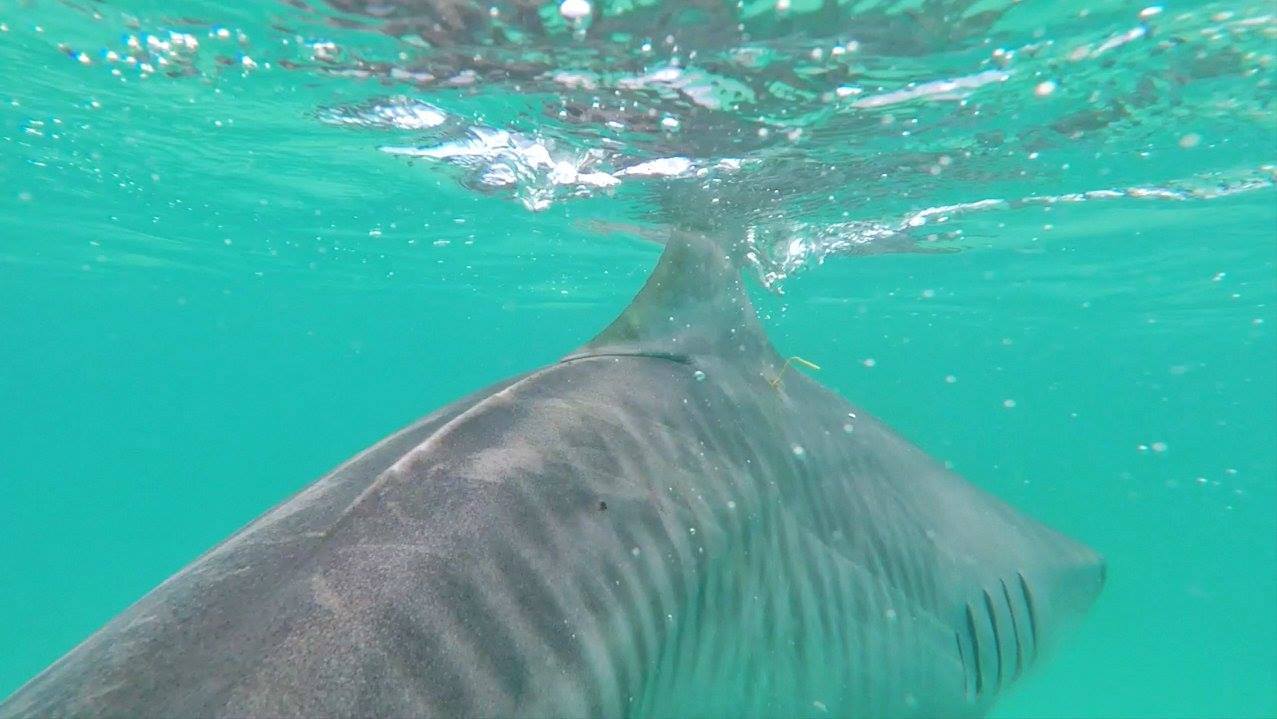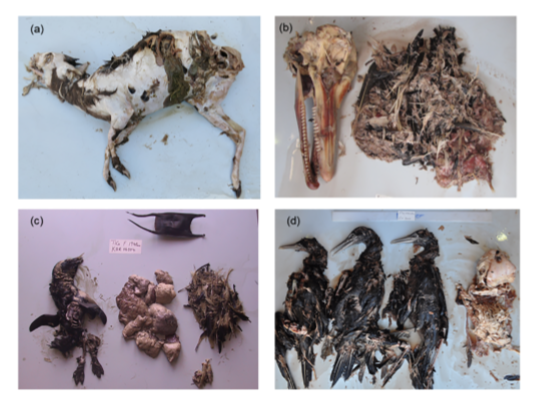The early shark gets the fish?
It’s 7 am, and I’m probably one of the only people in the world who is happy to wake up to a bucket of dead fish. Gross as it may sound, getting up close and personal with dead fish is entirely necessary for shark research. For a couple weeks over the summer, I’ve worked as a research intern on Moku o Loe Island, where the Holland Lab at Hawaii Institute of Marine Biology research facility is located. Many of my days would start with me throwing handfuls of fish into the shark pen, observing as the hammerheads and sandbar sharks excitedly surfaced for food, a ritual I could only describe as very similar to giving your dog treats.
Beyond providing the sharks their fishy breakfast feast, my days would range from staying in the lab or machine shop building tag packages, testing equipment or servicing fishing gear, to going out in the field, tagging, scouting bait for fishing or aiding with experiments on the island.
The Holland lab focuses on using and improving tracking technologies along with experiments in the lab to get a comprehensive picture of the movement and behavior of open-ocean animals, mainly sharks. Tracking technologies help scientists answer questions about where sharks travel, what they eat and where they eat it, and how they might interact with humans. Most of my work as an intern was centered around a tagging study on scalloped hammerheads, focused on temperature effects on their physiology. I was involved in the design and construction of tag packages, the actual tagging efforts, and taking care of animals in captivity.

What’s the deal with electronic shark tags?
The Holland lab uses two types of electronic tags:Transmitters and Dataloggers. Transmitters are placed on the animal and send data to receivers placed in the environment, while dataloggers store their data in the instrument. Even though they can store larger quantities of data, dataloggers need to be recovered to be dowloaded (versus transmitters that don’t require for tags to be recaptured).
There are many different tags that can be used for different goals and studies.There are acoustic pingers that send pings from the instrument to receivers, which makes it easy to observe movements of the sharks. Satellite tags that use radio transmission to communicate geographical location of the tag, and therefore are usually located on the fin of the shark to transmit a signal whenever the dorsal fin is over the surface of the water, and tri-axial accelerometer dataloggers,that are used in tag packages to measure acceleration in the x-y-z axes. This can be used to understand and reconstruct the movements of the shark’s body in all dimensions. Tags also have sensors to measure the environment in which the sharks are swimming, which most commonly include temperature, salinity, depth and light level, all things that can give scientists insight into the behavior of the animal and their preferred environment.

Tagging studies to answer tough temperature questions
The study I helped with, led by Mark Royer for his PhD dissertation research, was motivated by previous tagging observations, where it was identified that adult scalloped hammerheads, Syphrena lewini, tend to conduct deep night dives to around 800 m into cold 4 ºC hypoxic waters. This behavior is known as ‘yo-yo’ diving, and it is very common in pelagic fishes for foraging, navigation, energy conservation or thermoregulation. The study at hand was looking to answer questions about hammerhead yo-yo diving; lamnid sharks, such as White sharks and Makos, are known to be able to maintain their body warm, but this physiological ability hasn’t been identified in other sharks like the scalloped hammerhead. The study focused on explaining how hammerhead physiology can adapt to water temperature and depth changes. We wanted to use tag packages to get a picture of the shark’s internal and external environment during these dives, and figure out if the shark was diving down to the maximum depth, or diving without the goal of reaching the bottom.
Data collection: lots of behind-the-scenes details
A specific tag package was designed and deployed on sharks to better explore these questions. The tag included a depth sensor, a core muscle temperature sensor imbedded in the shark’s muscle to observe the temperature inside the body of the shark, an ambient seawater temperature water sensor to measure the temperature of the water outside and an accelerometer to gather body dynamics and orientation of the shark during swimming and yo-yo dives. Last but not least, the tag package also included a recovery mechanism that transmits a ping to a satellite after recovery. One of the packages also included a waterproof digital camera, which let us see the environment from the perspective of the shark.
The first step of the tagging procedure starts with scouting bait for our line. To do this, we would go to the Oahu fish auction, where we received scraps of fish tails, mainly tuna, that would be big enough and red enough to attract sharks. We used a longlining method to capture the shark participants in this study.
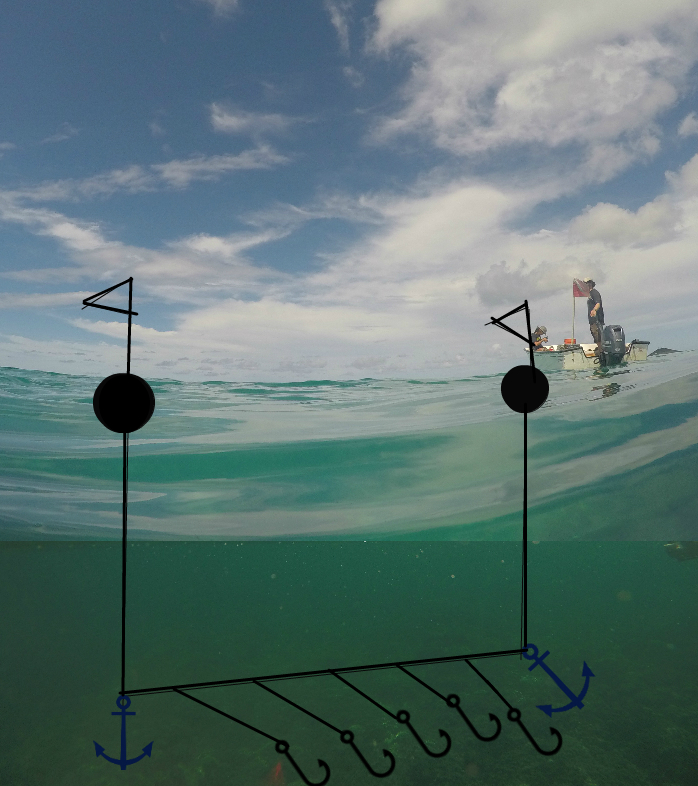
The method consists of attaching baited hooks on gangions to a single longline; the end of the line is marked by buoys on the surface, and anchored to the bottom to maintain it at the bottom. Scalloped hammerhead sharks are very sensitive species, and therefore minimizing the time the sharks spend on the line is very important for post-release survival. Since time is of the essence, we let the line stay in the water, or “soak”, for 2 hours, giving it enough time to attract sharks. This was also a short enough time that if an animal was hooked and we didn’t see it, it wouldn’t be in danger. During the two hours we would usually drive around the line looking out for shadows in the water. Once the two hours passed or we spotted an animal on the line, someone would haul the line in with a winch, while someone else would unhook all the baited lines from the main line until we reached the animal. Once we reached the shark, someone would take the baited line and strategically manipulate the shark to move parallel to the boat.
Caught a shark, now what?!
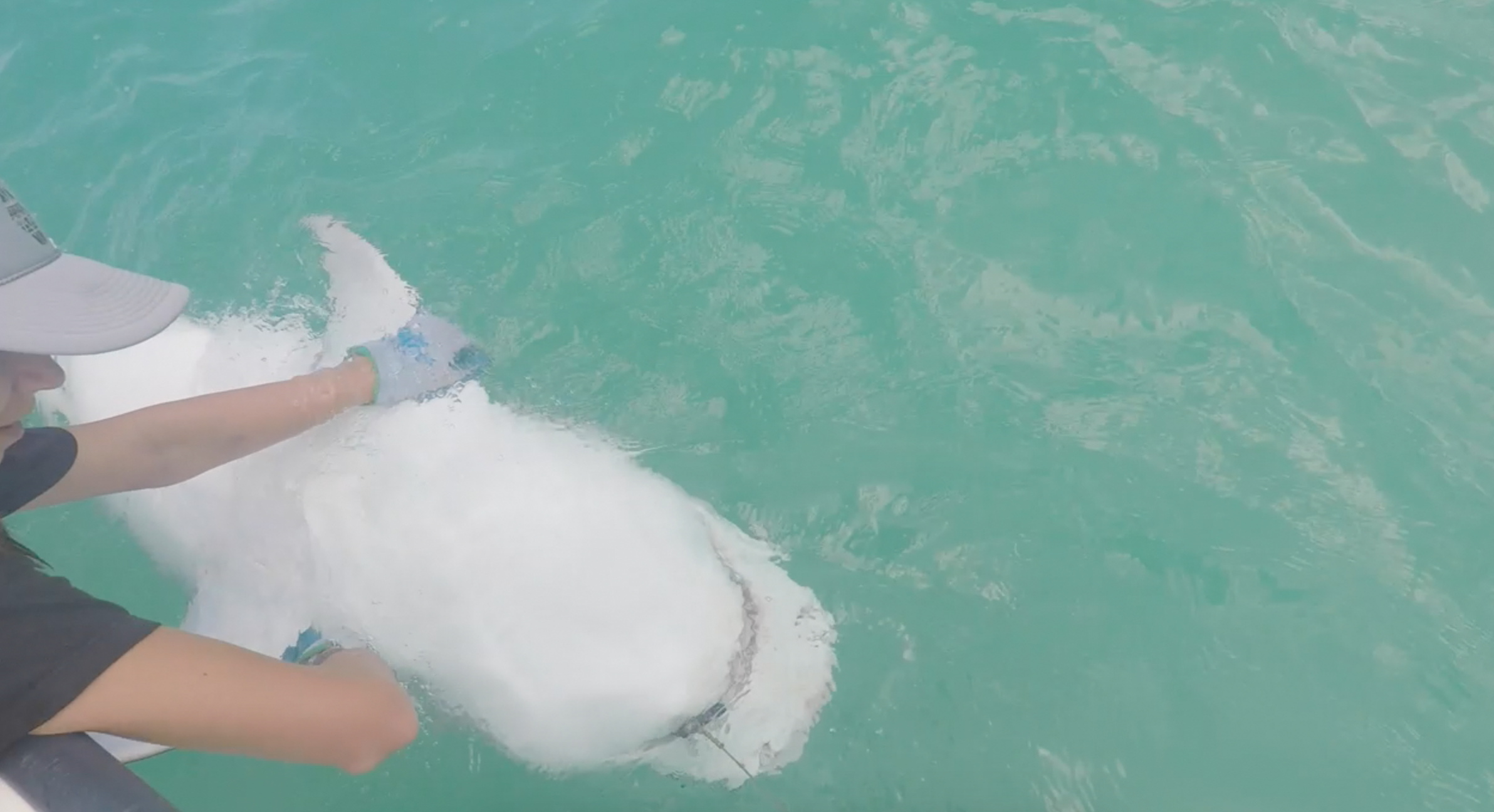
After positioning the caught shark along the boat, lines are appropriately placed to secure the shark to the boat while we worked. We would place a ventilator in the shark’s mouth to keep water flowing through the sharks gills; some sharks were turned on their back to calm down if they were too stressed.
Once the shark was secure, we started to collect data by measuring the length of the shark and noting its catch location. A tissue sample is taken from the base of the shark’s fin and stored on liquid nitrogen. We use the hole caused by the tissue sample to insert the tag 8 cm into the muscle of the shark. To secure the tag, a timer, which looks like a ziptie with a small capsule at the end, is set on the tag and through the sharks fin, which is programmed to unclip from the capsule at a set time, letting the tag naturally come out of the muscle of the shark, floating to the surface.
After the tag is secure, the shark is released; as it swims away, swimming pattern is observed carefully to make sure it is behaving normally. It is important to note that shark fins have no nerve supply, and in previous studies it has been established that sharks respond to injury as an unconscious reflex and the tagging procedure produces no pain response in the sharks.
Tag packages are carefully designed and placed on sharks to optimize data collection in a way that will avoid annoying the shark or cause it to change its behavior.

So much more than just field work
This research experience didn’t only teach me about the skills and hardships that go into field work and the tagging of sharks; the internship also taught me about the unpredictability of the shark scientist’s life. Besides tagging, I had the opportunity to observe other experiment-based research on the island, such as a study on magnetic field navigation of sharks.
Some of my favorite and most random experiences included testing of the digital underwater camera that was going on the tag package by going snorkeling around the island at night. We wanted to get an idea what the footage might look like at night and what the effect of the red light would be on the recording. Also, I had the chance to get into the shark pen; I helped reinforce the pen net with buoys to prepare for a king tide and prevent pen overflow and animal escape. I enjoyed this experience because, as any person would, I felt nervous in the water with animals so much larger than me, but I was in no way bothered by the sharks. I got to experience and understand that the sharks were harmless and were barely curious about my presence in the pen. This experience showed me how much media really affects our perspectives, even the perspective of the biggest shark lovers, such as myself. And even though sharks should be treated with respect, considering their size and predatory tendencies, they really have no desire to eat everything in their path, as they are portrayed in movies.
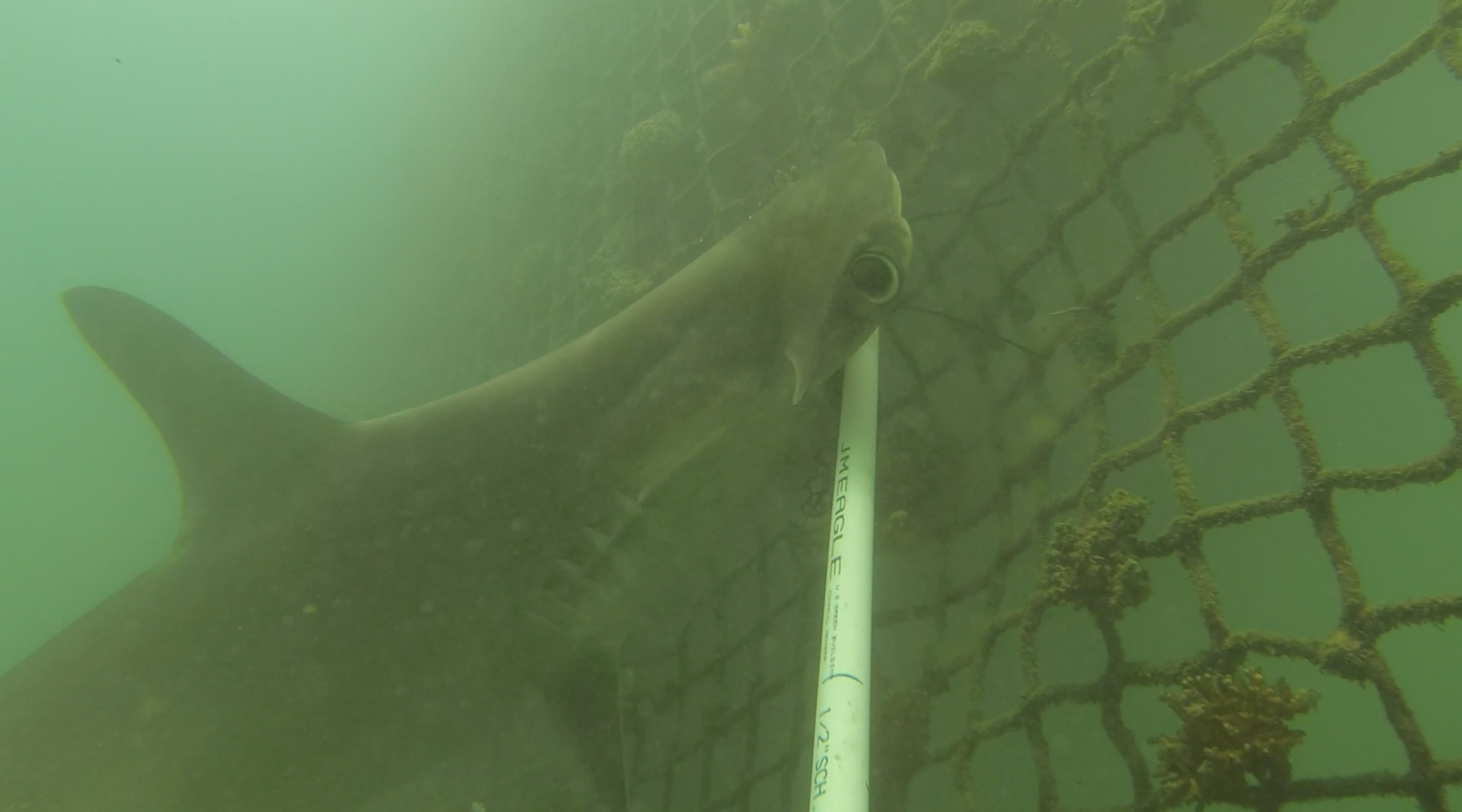
A day in the Holland lab was always different from the next, some very exciting days would follow very calm days, but every single day taught me something new. I learned how well-rounded a shark scientist needs to be; key assets include a little bit of an adventurous personality, some engineering skills, creativity, good navigation, swimming skills, and a strong stomach for all the smells involved in fishing and husbandry. Overall, I am thrilled with my introduction to shark research and tagging field work. Tagging is an important and useful tool that gives us insight into shark physiology and behavior; our understanding of shark physiology and behavior directly inform our ability to avoid or predict shark-human interactions. In the fight to protect sharks, the more we know, the better we can fit both human and shark needs.
Podcast: Play in new window | Download
I’m an Undergraduate student at University of Rhode Island majoring in Ocean Engineering and Marine Biology. I’m interested in the intersection between technology, biology and ocean exploration, as well as the application of such research to solve human problems.
I am also an advocate for shark conservation. Sharks have the unfortunate reputation of being man-eating monsters because of their portrayal in the media, and through human fear they have become some of the most vulnerable species on earth. My goal is to spread information about the importance of sharks to the balance of the ocean ecosystem, which directly affects the balance of the rest of the world. It’s a priority to learn to coexist, and protect our ocean and the future of our planet.

